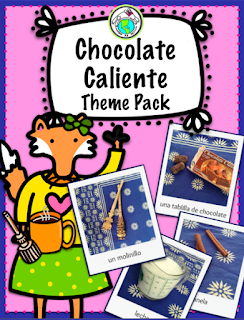THIS WEEK WE HAD OPEN HOUSE AT SCHOOL, and I wanted to make it more meaningful this year...our principal had referenced parents 'learning something' as they traveled through the many classrooms in our school, which inspired me to go beyond the typical 'meet and greet' I had always done. After searching on Pinterest for far too long, I came up with the following:
THREE THINGS TO DO WHEN YOU COME TO THE SPANISH ROOM: I created a printout of three things kiddos could do while visiting me:
1) Greet me with 'Hola'
2) Introduce their parents to Pepita and friends (they are such a part of our class I thought it would be fun to have parents introduced to them)
3) Do an estimation activity with a jar of Guatemalan worry dolls (which also gave practice for numbers) You can download my estimation activity for FREE here!
The kids had a lot of fun, especially with the estimation jar, and it was a great opportunity to showcase how well kids comprehend Spanish- many parents witnessed me speaking and prompting kiddos with the estimation slip, demonstrating how I teach in the target language while kids completed the task. I would love to hear how you do Open House!
Resources for Teaching Languages to Children
Search
Hispanic Heritage Month- Making Cultural Connections by Comparing a Taco
HISPANIC HERITAGE MONTH is a wonderful opportunity for our elementary Spanish students to learn more about how the influence of Hispanic culture has contributed to their own. Since we are talking elementary, I particularly like to provide concrete, tangible examples of how, in our everyday lives, we experience the many contributions we enjoy and which have become a part of the culture here in the US. I could get very sentimental and say that, after all, we are a melting pot, and our culture is an amazing amalgam of traditions, values, and customs from the world over... it truly brings tears to my eyes!
BUT, BACK TO HISPANIC HERITAGE MONTH! So, if you ask yourself the question, what does a 5, 6, 7 year old experience in his/her daily life that has come directly or in part from a Spanish speaking country, for the majority, the answer is mostly likely tacos and nachos and salsa! (Or, at least in my neck of the woods here in Maine...) And, most likely they have no idea that these yummy foods came originally from México AND most likely do not know or have ever had an authentic representation of tacos or salsa.
SO, WHY NOT TAKE THIS CONCRETE EXAMPLE OF MEXICAN CULTURE and share with your students the real deal? If you aren't able to bring in food, or have too many students to make it feasible, you can still show your students via videos and pictures more traditional representations. Here are some resources to compare and contrast Mexican tacos and those often eaten in the US:
THOUGH THE SPANISH in the video is most likely above your students' language level, the visual representation of a step by step recipe is a great way for kids to SEE the difference in tacos we frequently eat here (Ortega, anyone?). After viewing the video, and talking about the differences (both in how they are made and the ingredients) between a taco in México and the US, have your students do a Venn diagram with visual representations of the differences- here is a FREE downloadable Venn diagram activity page! This is also a great activity to meet ACTFL Standard 4.2 (Students develop understanding of the concept of culture through comparisons of the cultures studied and their own) And here are a few links to infographics on Pinterest about tacos: https://www.pinterest.com/pin/3588874686778701/ and taco de asado https://www.pinterest.com/pin/3588874686778701/
HOW ABOUT PICO DE GALLO? Check out our post here on making salsa tipo pico de gallo! And don't miss our 'Olivia hace chocolate caliente' Activity Pack- two great additional opportunities for cultural comparisons!
SaveSaveSaveSave
BUT, BACK TO HISPANIC HERITAGE MONTH! So, if you ask yourself the question, what does a 5, 6, 7 year old experience in his/her daily life that has come directly or in part from a Spanish speaking country, for the majority, the answer is mostly likely tacos and nachos and salsa! (Or, at least in my neck of the woods here in Maine...) And, most likely they have no idea that these yummy foods came originally from México AND most likely do not know or have ever had an authentic representation of tacos or salsa.
SO, WHY NOT TAKE THIS CONCRETE EXAMPLE OF MEXICAN CULTURE and share with your students the real deal? If you aren't able to bring in food, or have too many students to make it feasible, you can still show your students via videos and pictures more traditional representations. Here are some resources to compare and contrast Mexican tacos and those often eaten in the US:
THOUGH THE SPANISH in the video is most likely above your students' language level, the visual representation of a step by step recipe is a great way for kids to SEE the difference in tacos we frequently eat here (Ortega, anyone?). After viewing the video, and talking about the differences (both in how they are made and the ingredients) between a taco in México and the US, have your students do a Venn diagram with visual representations of the differences- here is a FREE downloadable Venn diagram activity page! This is also a great activity to meet ACTFL Standard 4.2 (Students develop understanding of the concept of culture through comparisons of the cultures studied and their own) And here are a few links to infographics on Pinterest about tacos: https://www.pinterest.com/pin/3588874686778701/ and taco de asado https://www.pinterest.com/pin/3588874686778701/
HOW ABOUT PICO DE GALLO? Check out our post here on making salsa tipo pico de gallo! And don't miss our 'Olivia hace chocolate caliente' Activity Pack- two great additional opportunities for cultural comparisons!
SaveSaveSaveSave
Subscribe to:
Posts (Atom)





